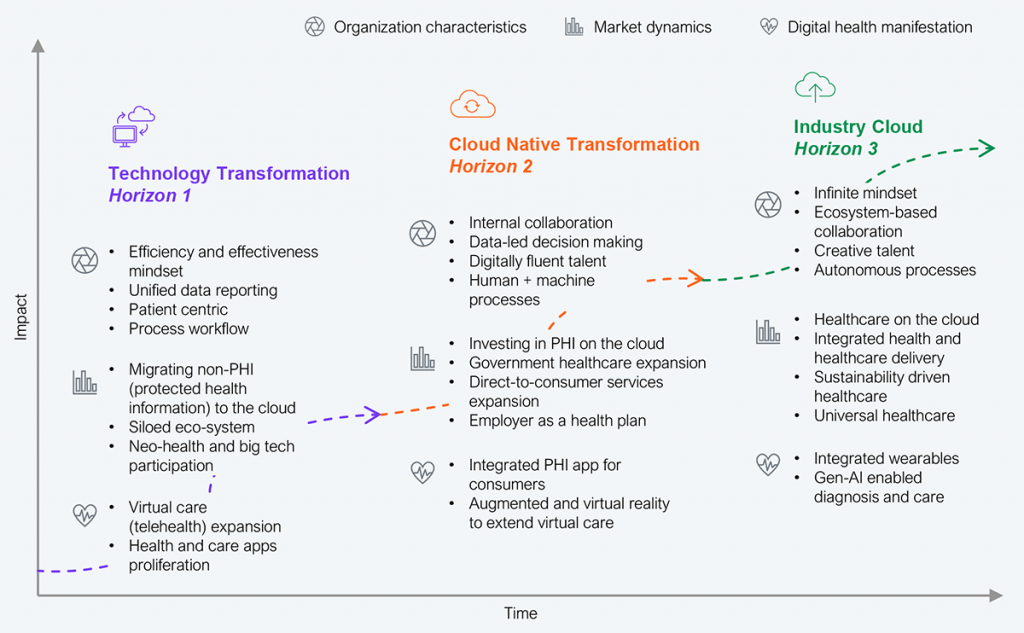OptaFi is a joint venture between Sentara Health and Infinite Computer Solutions, created in 2022 to modernize healthcare by providing a reliable pathway to digital health. Sentara has a storied history, dating back to 1888, of delivering care to the Norfolk, VA community and expanding beyond with health plans and healthcare facilities. Sentara’s collaboration with Infinite Computer Solutions (a diversified technology service provider based in Rockville, MD) to create OptaFi reflects its journey to adopt cloud in a highly regulated and clinically sensitive environment, the successes they found, and the desire to deliver similar benefits to other hospitals, health systems, and health plans. Given healthcare enterprises continue to lag in their cloud journey, the value OptaFi has created is encouraging.
An industry cloud is a cloud platform designed to meet an industry segment’s specific needs and create new levers of value. Industry cloud has become the next iteration of the cloud narrative, which has rapidly devolved into becoming lipstick on a pig. The cloud providers are essentially hyperscalers whose success is tied to consumption and enterprise application providers attempting to make their complex platforms work in an industry context. It’s no wonder, then, that an HFS Research study revealed that across industries, only 32% of enterprises are realizing their cloud ambitions, a far cry from the narrative in the industry.
Industry cloud is not a tactical deliverable; rather, it reflects the creation of new value through various levers, including a cultural shift, adoption of new business models, ecosystem-driven collaboration, and more (see Exhibit 1). Simply put, the evolution of cloud-enabled transformation is about progressing from efficiency gains and agility through industry-specific capabilities to value creation. OptaFi’s track record suggests the alignment with the HFS Industry Cloud Continuum and outcomes that are expected from such a deliberate approach.

Source: HFS Research, 2024
While technology is central to how health systems (providers) and health plans (payers) deliver their services, they are not tech natives. So, as healthcare enterprises (providers and payers) attempt to embrace new technologies and the cloud in particular, they often lack methodologies and practices to move a healthcare enterprise to the cloud completely and effectively.
There is a propensity for healthcare enterprises to move tactically (a couple of servers) to the cloud, perpetuating past mistakes, instead of taking a whole-of-a-company strategy that would mitigate them. As a result, there is an inconsistent understanding of the benefits outside of the brute idea of cost reductions.
The genesis of OptaFi’s creation is in the cloud journey that Sentara Health took with Infinite Computer Solutions. Over four years, Sentara went from zero cloud presence to about 80% of its health system and health plan on the cloud. This atypical journey for a healthcare enterprise helped OptaFi define its approach to helping other providers and payers with their cloud journeys. It starts with optimizing business processes and adapting the enterprise culture to the journey, recognizing that this is not just an IT project but an enterprise transformation for a better future. This transformation allows for clarity on what success looks like from process optimization, financials, and compliance.
The framework OptaFi adopted is collaborative and best reflected in its deployment, where architects, engineers, and security iterate to ensure success. As a result, OptaFi has been able to craft standards, accelerate deployment, and do it securely.
OptaFi’s solution starts with crafting a cloud strategy, ensuring clarity of purpose and the outcomes that can be realized in alignment with the phased approach of moving workloads. Deployment combines a security framework that envelopes the cloud and allows automated delivery into a zero-trust framework. OptaFi incorporated the National Institute of Standards and Technology (NIST) into its security framework and has a patent on the IP. The solution enables the creation of a highly controlled environment that allows healthcare enterprises to automate deployment, innovate faster, and reduce costs by being able to adopt technologies rapidly.
… we’re now having a real business discussion about IT…we are having value-based conversations about capabilities…
– Jeff Thomas, SVP and CTO, Sentara Health
Migrating electronic health records (EHRs) to their new cloud environment is a complex process that requires a deep understanding of enterprise culture and its cloud vision. It also involves integrating with multiple vendors, their playbooks, and enterprise teams to successfully navigate and complete migrations.
In the short time OptaFi has been operating, it has notched significant engagements, particularly with Epic migrations to the cloud for three providers and two payors, including Sentara Health and Centene. The migrations’ success is reflected in the speed, which is typically 40% to 60% faster than average migrations in the market. That speed translates into reductions in implementation costs and enterprise operational friction. There is an overall acceleration to business case returns that are committed to.
In real terms, for an integrated delivery network (IDN), OptaFi’s help migrating to the cloud has helped keep costs flat. However, the need to expand infrastructure to operate Epic continues to grow, given the requirement to maintain up to 120% of the required capacity. This math points to reduced operating costs; at scale, it is a significant portion of EBITDA.
While cloud transformation and migration have been part of the technology modernization portfolio, movement across healthcare in real-world outcomes has been underwhelming. In part, it reflects the operational challenges, cultural barriers, and lack of clarity on the benefits beyond cost reduction. Hyperscalers have crafted “industry cloud” solutions and marketing narratives around it, but on-the-ground realities have not seen any real transformation. OptaFi’s approach to being a healthcare-only cloud transformer incorporates the tricky nuances of the industry combined with the number of wins. It suggests that the approach OptaFi is advancing is likely to return real outcomes to healthcare enterprises rather than engaging in an open-ended science project.
Register now for immediate access of HFS' research, data and forward looking trends.
Get StartedIf you don't have an account, Register here |
Register now for immediate access of HFS' research, data and forward looking trends.
Get Started